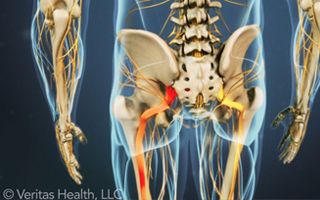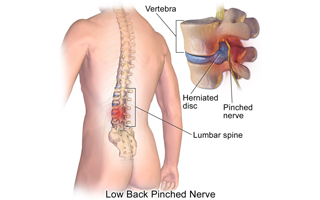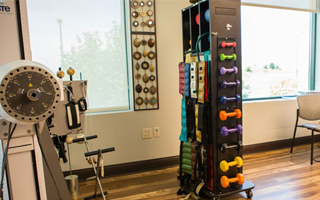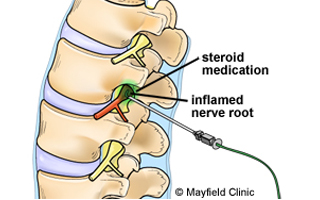Treat Sciatic Nerve Pain at MidAmerica’s Palos Hills & Mokena Locations

Sciatica is a term describing the symptoms of leg pain originating in the lower back, traveling through the buttock and down the sciatic nerve located at the back of each leg. The sciatic nerve is the largest single nerve in the body, made up of individual nerve roots branching from the spine in the lower back.
Symptoms
Sciatica symptoms occur when the sciatic nerve is compressed or irritated near its point of origin. However, sciatica is not a medical diagnosis; it is a symptom of an underlying medical condition that causes sciatic pain.
Sciatic nerve pain varies from infrequent and irritating to constant and debilitating. Symptoms are usually determined by the location of the pinched nerve. Common symptoms include:
- Leg pain described as tingling, burning, or searing
- Weakness, numbness or tingling in the foot or toes
- Sharp pain making it difficult to stand or walk
- Constant pain in one side of the buttocks (rarely both sides)
- Pain that increases when sitting
While sciatica can be painful, it’s rare that permanent nerve damage will result. This condition normally affects adults between the ages of 40 and 50 years old, and some research suggests that up to 43% of the population will at some point experience sciatic nerve pain.
Causes
Being that sciatica is not a diagnosis in and of itself, the following four lower back conditions are considered the most common causes:
 Lumbar Herniated Disc - Discs are the soft rubbery pads between vertebrae. Discs in the lumbar spine are comprised of an outer ring of cartilage called the “annulus” and an inner gel-like substance called the “nucleus.” A herniated disc (also known as a slipped disc, ruptured disc, or protruding disc) occurs when the nucleus pushes through the annulus, resulting in pinching or inflammation of the the nerve root. While herniated discs have multiple causes and symptoms, sciatic nerve pain is commonly cited.
Lumbar Herniated Disc - Discs are the soft rubbery pads between vertebrae. Discs in the lumbar spine are comprised of an outer ring of cartilage called the “annulus” and an inner gel-like substance called the “nucleus.” A herniated disc (also known as a slipped disc, ruptured disc, or protruding disc) occurs when the nucleus pushes through the annulus, resulting in pinching or inflammation of the the nerve root. While herniated discs have multiple causes and symptoms, sciatic nerve pain is commonly cited.
Degenerative Disc Disease - Disc degeneration is a natural process that occurs with aging. One or more degenerated discs in the lower back will release inflammatory proteins from inside the disc, irritating the nerve roots in the area, often resulting in sciatic nerve pain.
Isthmic Spondylolisthesis - This condition occurs when a small stress fracture allows a vertebrae to slip forward and place pressure on another. This causes a collapse, fracture, and vertebral slip, that pinches the nerve root and results in sciatica.
Lumbar Spinal Stenosis - Lumbar Spinal Stenosis involves the narrowing of the spinal canal and is a common occurrence during aging. This condition usually results from a combination of enlarged facet joints, soft tissue overgrowth, and a bulging disc placing pressure on the sciatic nerve. Spinal Stenosis often occurs alongside spinal arthritis, which may also contribute to sciatica symptoms.
Nonsurgical Treatment
The goals of nonsurgical treatment for sciatica focus on relieving pain and neurological symptoms resulting from the pinched nerve root. There are a broad range of treatment options available, usually recommended in conjunction with an exercise or physical therapy routine. Common home treatments include:
- Heat/Ice - Heat/Ice packs are readily available and help relieve sciatic pain in its initial stages. Either can be applied in 20 minute increments approximately every two hours. The heat and ice treatment may be alternated as symptoms progress. Many patients treat themselves with ice initially, but find greater relief with heat over time.
- Pain Medications - Over-the-counter NSAIDs, such as acetaminophen and ibuprofen, are often effective means to reduce sciatica inflammation and reduce pain. Additionally, muscle relaxants may be prescribed by a physician for a short-term use (up to two weeks) to further alleviate pain.
![spine]() Epidural Injection or Epidural Steroid Injections - In severe cases, epidural injections may be recommended by a physician to reduce pain. Unlike oral medication, injections go directly to the painful area around the sciatic nerve to address inflammation. Results are temporary, providing patient relief for one week up to a year, and does not work for everyone. Injection treatment is often paired with a specific conditioning or exercise program.
Epidural Injection or Epidural Steroid Injections - In severe cases, epidural injections may be recommended by a physician to reduce pain. Unlike oral medication, injections go directly to the painful area around the sciatic nerve to address inflammation. Results are temporary, providing patient relief for one week up to a year, and does not work for everyone. Injection treatment is often paired with a specific conditioning or exercise program.
For most patients, sciatica typically gets better on its own, and the healing process usually only takes a few days or weeks. The majority of patients find their pain subsides within a 6-12 week time span. Following pain relief, a physical therapy program may be recommended by a physician to alleviate residual pain and prevent future injuries.
Surgery
While most cases of sciatic nerve pain dissipate on their own, surgery available at MidAmerica’s Palos Hills and Mokena clinics for those who do not find relief from pain that lasts six weeks or more and those who cannot participate in their daily activities.
Dr. George Charuk, D.O.
Additionally, Physical Medicine and Rehabilitation Specialist, Dr. George Charuk, treats conditions of the neck and lower back (including sciatica) using a comprehensive program of minimally invasive, non-operative, and physical therapy techniques.
Dr. Charuk understands that pain can be a major hurdle to living a normal life and believes the best way to heal the body is to help the body heal itself.

Post-Surgery
At MidAmerica’s Palos Hills and Mokena, our post-surgery physical therapy program consists of recommended exercises and stretches, as well as training in proper bending and lifting techniques to avoid future injuries. Common exercises following MISS surgery include:

To learn more about MidAmerica Orthopaedics Palos Hills and Mokena and the different treatment options available to you, visit our website. We also proudly serve Chicago, Oak Lawn and Orland Park.
To schedule an appointment with MidAmerica Orthopaedics, call (708) 237-7200.

 Epidural Injection or Epidural Steroid Injections - In severe cases, epidural injections may be recommended by a physician to reduce pain. Unlike oral medication, injections go directly to the painful area around the sciatic nerve to address inflammation. Results are temporary, providing patient relief for one week up to a year, and does not work for everyone. Injection treatment is often paired with a specific conditioning or exercise program.
Epidural Injection or Epidural Steroid Injections - In severe cases, epidural injections may be recommended by a physician to reduce pain. Unlike oral medication, injections go directly to the painful area around the sciatic nerve to address inflammation. Results are temporary, providing patient relief for one week up to a year, and does not work for everyone. Injection treatment is often paired with a specific conditioning or exercise program.